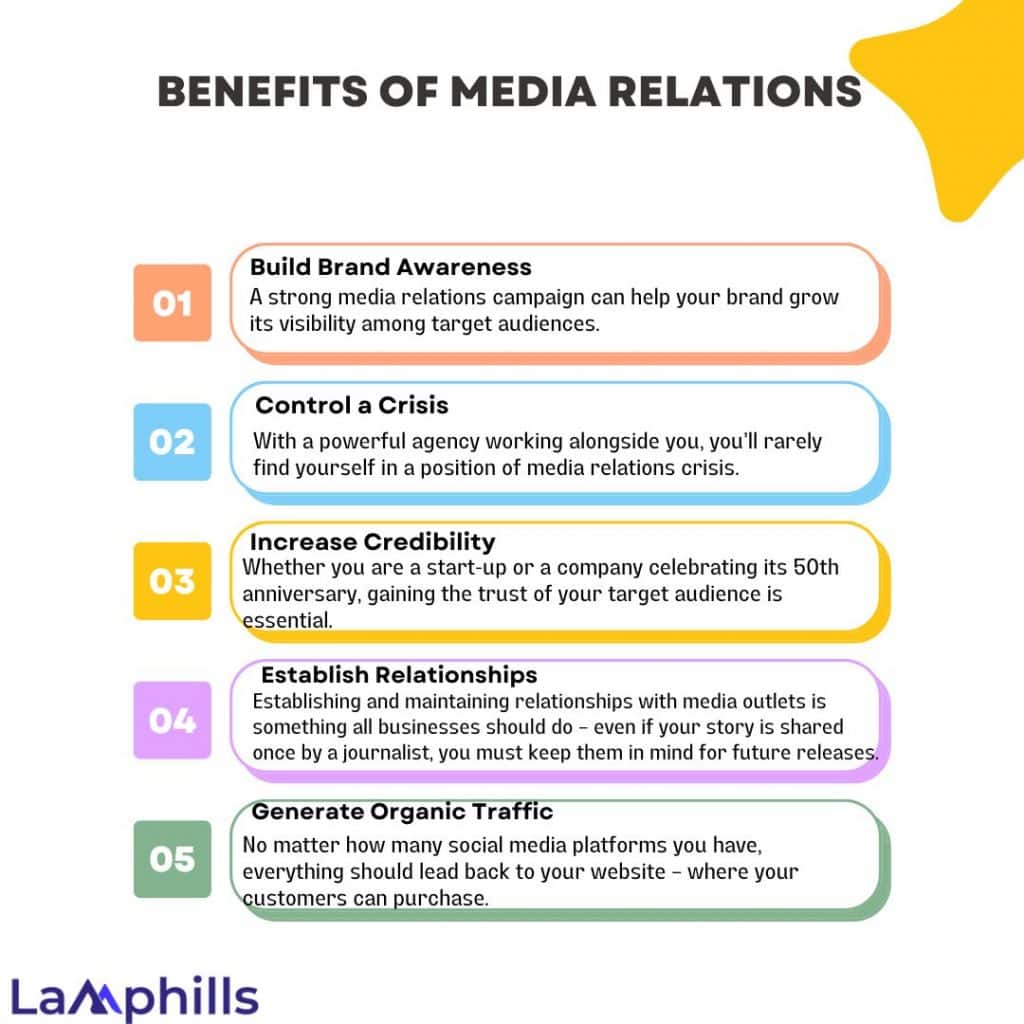If you watch many TV shows, you might think it’s the job of the police service to communicate with the press about cases. If you’re in business, you might think it’s basically the same thing as PR. Or you may have just heard the term come up in conversation, but not really know what it means. Don’t worry; all of us started somewhere, and media relations is a very specific area of marketing that many businesses don’t consider for the first few years of life. But what exactly is media relations, and is it something your business needs?
Key Points
- Media relations is a mutually beneficial relationship between journalists and public relations professionals.
- Media relations aim to maximize positive coverage in the mass media without paying for it directly through advertising.
- Media and public relations (PR) are aspects of a business’s approach to publicizing its offerings and brand mission. Media relations is a subset of PR that focuses on working with the news media, while PR is a broad strategy that encompasses many tactics, including media relations
- The top benefits of media relations include building brand awareness, increasing credibility, establishing strong media relationships, generating organic traffic, and controlling crises.
- Media relations specialists are PR professionals who build and maintain relationships with media outlets.
What is Media Relations?
Media Relations involves working with media to inform the public of an organization’s mission, policies, and practices in a positive, consistent, and credible manner. It can also entail developing symbiotic relationships with media outlets, journalists, bloggers, and influencers to garner publicity for an organization. Typically, this means coordinating directly with the people responsible for producing the news and features in the mass media. Media relations aim to maximize positive coverage in the mass media without paying for it directly through advertising.
While the terms “public relations” and “media relations” are often used interchangeably, “media relations” describes a company’s or organization’s relationship with journalists. In contrast “public relations” expands that relationship to include the broader public. Like direct marketing, integrated marketing brings together all facets of marketing communications. Direct marketing, public relations, sales promotion, marketing, and social media can all be utilized to develop consistent messaging targeted to the consumer’s needs.
So, what are the major differences between media relations and public relations?

#1. Public Relations Molds the Message. Media Relations Offers a Large Platform
Public relations specialists are responsible for crafting the message that reflects the brand. These people can assist in spreading that message thanks to the abundance of resources available today. People frequently ask to “make it go viral” or “put some dollars behind it” in an attempt to increase the visibility of a message; however, the media remains the original megaphone and one of the most reliable (and frequently affordable) ways to expand the message’s audience. Your company’s story may get more exposure if you can tie it into a current event, a well-known person’s profile, or something affecting a particular neighborhood. You can also connect your story with the appropriate media outlet.
#2. Public Relations Uses Multiple Channels to Generate Public Exposure. Media Relations Uses One — The Press
Public relations looks to build relationships between organizations and stakeholders. To do so, PR pros might use a variety of channels — a company blog, social media, or even a special event — to communicate directly with those individuals. Media relations focuses on one key channel: the press. Using the press as the channel to communicate with stakeholders allows you to meet those stakeholders where they already are — using what they’re already reading, watching, or listening to adds third-party validation to your message. That third-party validation is valuable. Consider how much more powerful a message can be from Forbes than your recently-established company’s Twitter account.
#3. Public Relations Is the Rectangle. Media Relations Is the Square
Remember this adage from geometry class: All squares are rectangles, but not all rectangles are squares. This is true because a square is a particular type of rectangle, one where all the sides are the same length. The same applies to public relations and media relations — all media relations is public relations, but not all public relations is media relations. In other words, media relations is a unique subset of public relations. If your business is looking for earned media coverage, focusing on this particular type of public relations is essential.
Why Are Media Relations Important?
Media relations are important if you’re looking to generate brand awareness. This is because of the potential to reach a large audience with your message. Media could include online or print magazines, newspapers, podcasts, radio, and television. Appearing on one of these mediums can give you the credibility you need to start garnering attention and interest for what you do or to maintain or increase it.
They are essential for your future endeavors, too. You can leverage these relationships for future promotion and publicity by building on these relationships.
Media relations are also beneficial in times of crisis. Good relationships with those in media positions can mean the outflow of timely and accurate information to the public, reducing potential damage.
How Do You Do Media Relations? Tips and Strategy
Here are some of the best tips and media relations strategies for effective results.
#1. Start With a Clear Strategy
Launching a PR campaign without a clear strategy is like getting dressed in the dark. You could get by, but the result won’t look tidy.
Instead, document your PR plan for every PR campaign you create before you even begin building your contact database. You can’t communicate effectively without first understanding what you’re selling, why it has a unique value in the current marketplace, and who you need to share this message with.
It can be as simple as a one-pager, but determine and record:
- What makes your client or company special
- Who their potential customer is
- Where that customer learns about new products (get specific about types of magazines, podcasts, blogs, and social media influencers)
- Why the media should cover your product or service
- When you launch the campaign, and how long will it last
- How success will be measured for your PR campaign (e.g., number of mentions, influencer collaborations, specific media mentions)
#2. Build Your Team
If you’re lucky enough to have an agency or in-house team, it’s time to get everyone on board with your campaign strategy. Media relations rely on a clear, consistent message, so you’ll want everyone on the same page.
This is especially true if you’re team pitching. You’ll want every team member well-versed in the product’s benefits, the company’s values, and the campaign’s desired result.
Start each PR campaign with a kick-off meeting to review your strategy, answer questions, and elicit and listen to feedback. If you can’t sell your team on the viability of your campaign, how will you sell it to the media?
Integrate team feedback into your strategy to finalize it, and then confirm buy-in from all involved with the campaign.
Also, have a detailed plan to document and share team notes – details are everything in building valuable media relations.
This will help you keep track of all your interactions with each of your contacts and give your team some hints on who’s speaking with whom about what. This is particularly useful for teams working with the same media lists.
Protip: If a journalist you’re in contact with is going on holiday next month, note this fact so that you’ll remember to ask how the trip was the next time you speak with them. You can easily add notes, tags, and team comments using a PR CRM.
Finally, remember to include adjacent marketing professionals working with the client outside the PR sphere. Social media strategists, ad managers, content writers, and even sales teams should be aware of and up-to-speed on your PR campaign. Partnering efforts will only amplify your messaging and offer you a greater chance of success.
#3. Write to Compel
With a strategy and the ability to envision your target audience, you can begin creating your brand story. Most often, this takes the form of a press release.
Be creative, but adhere to the fundamental principles of media and public relations writing:
- Entice with an exciting headline.
- Summarize the key points quickly in the opening paragraph.
- Follow up with details and spokesperson quotes.
- Provide contact information for follow-up questions and requests.
And avoid vague “smoke and mirrors” language at all costs.
For example, consider utilizing general statements such as, “We are pleased to introduce a groundbreaking new certification system that will completely transform the industry.” When a journalist reads your press release, he or she might be curious, but what exactly does that mean?
If the journalist can’t easily understand your main points quickly, and you fail to provide supporting evidence and details quickly, the reader surely won’t understand it either. A journalist may pass on the story if something is as simple as this, instead of chasing clarifications and details.
Instead, blend a straightforward narrative with specific details like any great storytelling. Imagine that you’re outlining the article for the journalist and offering up all the pieces they’ll need to win over readers with a compelling headline and a newsworthy article.
#4. Know Who You’re Talking To
Every journalist is different, even within the same publication. One journalist’s newsworthy story may be different from the next, so it’s important to know who your target journalist is. Research and find out who writes about your industry regularly and whether they’re still with your target publication. This is to avoid fruitless attempts of reaching out to the wrong person and getting discouraged when you don’t get a response.
The important thing is to remember not to waste their time and yours. A technology journalist probably won’t care about pitches or invites to the launch of a new beauty product and neither would an economic correspondent want to receive new hire announcements.
#5. Measure Your Success
At this point in your campaign, you’re ready to measure success. This is where all the work you invested in your initial PR strategy comes in.
Since you set clear and measurable goals, such as sending samples, conducting interviews, or gathering event attendees, you can now compare these numbers against your final results.
If you made or exceeded your goals, well done! But if you didn’t meet your benchmark goals, that’s OK, too. You and your team can confidently review the results because you went into your campaign with a clear and methodical strategy.
Together, you can determine your campaign’s weak spots, investigate whether you got the media contact list just right, and share notes on recurring journalist questions that might indicate that your press release wasn’t clear enough.
You’ll be armed with more guided information and precise corrections for your next campaign, which is a big win.
Media Relations Checklist
In today’s world, navigating media relations can be tricky. There are many elements to great media relations. To help you, I’ve made a checklist guide of things you need to consider.
Lamphills Media Relations Checklist
What Are the Five Benefits of Media Relations?

In today’s competitive marketplace, media relations can deliver benefits unmatched by any other marketing communications activity. When done correctly, it can deliver advantages that no other marketing strategy can achieve. Although media relations have evolved over the past few years, public relations professionals have adapted to these changes, allowing them to continue to reach a large audience cost-effectively.
Here are 5 key benefits of incorporating media relations into your public relations strategy.
#1. Build Brand Awareness
A strong media relations campaign can help your brand grow its visibility among target audiences. By incorporating media relations into your overarching marketing communications plan, you can build brand awareness by securing positive coverage in trusted media outlets. Your public relations agency will develop a custom media database of outlets to target for coverage based on various factors, including your location, geographic reach, industry, and target audiences.
They will likely seek to garner stories about your brand in various outlets, including newspapers, websites, blogs, podcasts, television stations, radio shows, etc. The media coverage that results from their outreach can come in many forms.
#2. Control a Crisis
With a powerful agency working alongside you, you’ll rarely find yourself in a position of media relations crisis. Having existing relationships with the media allows you to act faster than you usually would if a crisis were to occur – not only can a crisis be detrimental to your brand, but it can also spread quickly.
Reaching the right contacts means you can act on the matter efficiently and in good timing, allowing you to control what’s being spread by taking advantage of your close working relationships.
Media relations agencies offer an extensive list of services, including branding. The image of your company matters, which is why they dedicate so much time to the initial stages of working with you, ensuring that your brand is being painted in the right way before they contact media outlets to share your stories.
#3. Increase Credibility
Whether you are a start-up or a company celebrating its 50th anniversary, gaining the trust of your target audience is crucial. Customers tend to be loyal to brands and products in which they have confidence. Most people use the same product, company, organization, etc., for years because they develop a brand bond, and it can be hard to convert them to something new. Looking to be the brand a customer sticks with for such a long time? Media coverage can help achieve this by promoting authenticity, trust, transparency, and credibility. Customers are loyal not only to brands or organizations but also to media outlets. Think about it: everyone has 2-3 go-to media sources for news consumption, so it’s essential to have a media relations team that understands the media world and knows which outlets to target to ensure your content is seen by the right audience.
Regarding credibility, it’s essential to understand what your target customer is looking for in a brand. According to a recent study by Forbes, 33% of millennials rely on blogs before making a purchase, and 43% value authenticity over content when consuming news. Blogs and influencers are so popular nowadays because they are both known for their authenticity. Especially in a day and age where it can be hard to differentiate between sponsored and organic media, consumers want to know what they consume is authentic and genuine. Therefore, it’s essential to align your brand with trusted media outlets that can portray your brand’s transparency to audiences.
Once your brand is established and growing in the media world, those media relationships can be ever-growing and evolving.
#4. Establish Relationships
Establishing and maintaining relationships with media outlets is something all businesses should do – even if your story is shared once by a journalist, you must keep them in mind for future releases. Journalists appreciate being contacted, especially when you personalize and tailor your media pitch to them.
You’re more likely to have a successful response from your media pitch if you’ve previously worked with certain media outlets, this is why we keep all of our journalistic contacts in mind for our clients. Online and offline relationships should be taken seriously in business – there can be many disadvantages to losing beneficial contacts.
#5. Generate Organic Traffic
No matter how many social media platforms you have, everything should lead back to your website – where your customers can purchase. Ensuring organic traffic to your website is important – your customers shouldn’t just be engaging with your social media channels.
Although having a strong social media presence is necessary, it’s vital that your customers feel the need to explore your business further by visiting your website, reading your blogs, and buying into the services you’re providing.
With the right press coverage, you should expect an influx of traffic to your website. Not only does media coverage encourage people to visit your website, but it also helps boost your SEO rankings – our team of experts creates compelling content that can be put out to media outlets.
Any successful media relations campaign should generate adequate traffic to your website, but we understand this is hard to achieve. Knowing who to reach out to and get your stories to the right group of people can be challenging, so it’s essential to have a PR agency with a difference like Lamphills to help.
Who is a Media Relations Specialist?
Media relations specialists are PR professionals who build and maintain relationships with media outlets. Their primary task is to secure publicity for their company and ensure it receives positive coverage. Although their tasks may vary based on the size of their company, these are some of the most common duties for media relations specialists:
A media relations specialist manages the flow of communication between a company or client and the media. The director builds and fosters relationships with key stakeholders across traditional and online media channels; establishes and implements strategic communications plans; and develops, writes, and/or approves messaging for press releases and pitches, talking points, social media accounts, speeches, media statements, op-eds, letters to the editor, etc.
Other responsibilities include positioning clients and company leaders as subject matter experts, monitoring and tracking media coverage, organizing media briefings and press conferences, managing crisis communications, media coaching, and serving as official company spokesperson.
Media Relations Job Description Template
This job description provides an overview of the general type and caliber of work carried out by those appointed to this role.
Lamphills Media Relations Specialist Job Description
Media Relations Skills
Media relations specialists require various skills and competencies to promote and protect their brands. These are some of the most essential skills for professionals who want to pursue a media relations career:
#1. Interpersonal Skills
Media relations specialists must understand how people might respond to a message from their client or organization. They must also be open and friendly to build strong relationships with media members and ensure accurate and positive coverage of their clients.
#2. Speaking
On some occasions, media relations specialists may serve as spokespeople for their organization. They must respond articulately to challenging questions while sticking to pre-approved talking points to represent their organization or client favorably.
#3. Writing
Many media relations specialists draft speeches and press releases. They may also manage social media posts and captions across several platforms. Their written communication skills must be as strong as their public speaking abilities.
#4. Organization
Media relations specialists almost always have several balls in the air. Whether writing speeches, calendaring social media content, or creating an overall strategy and image, media relations specialists must stay organized while multitasking.
#5. Problem-Solving
A major element of media relations is crisis communication. Under difficult circumstances, public relations specialists must know how to solve problems and find the best path for their clients.
Media Relations Jobs
While media relations is a relatively small field, several jobs require expertise in media relations.
#1. Media Relations Manager
Primary duties: Media relations managers are senior professionals in charge of overseeing communication between companies and media outlets. These professionals often start their careers as media relations specialists. Common duties for media relations managers include developing a brand voice and communication strategy, training employees in external communications, leading a staff of PR and marketing professionals, monitoring media activity and compiling reports, writing press releases, and promotional materials, building and maintaining relationships with media outlets, responding to media inquiries, responding to PR crises and sometimes acting as a spokesperson for their company.
#2. Communications Specialist
Primary duties: Communications specialists are professionals who manage all forms of communication between their company and the outside world. While their job is similar to media relations, they may have a wider scope of duties. Common tasks for communication specialists include developing communication strategies, writing content for websites, blogs, and social media, preparing press releases, planning promotional events and press conferences, developing style guides and brand guidelines, building relationships with external entities, evaluating the success of promotional campaigns, and screening communications.
#3. Public Relations Specialist
Primary duties: A public relations (PR) specialist is a professional responsible for maintaining their brand’s positive public image. They may also work to increase publicity around their company. Primary duties for PR specialists include formulating publicity and public relations strategies, managing brand voice on social media, drafting promotional materials, arranging promotional events, managing media inquiries, building relationships with customers, media organizations, and special interest groups, resolving disputes, and writing press releases.
Bottom Line
In conclusion, you should now be able to define media relations, distinguish them from public relations, and understand how they work together. Public relations includes many facets, of which press relations is one of the most significant.
With careful planning and well-thought tactics, you can build productive and long-lasting relationships with the media that benefit all parties, elevating your business above the competition.
Similar Articles
- MARKETING METRICS: Meaning, Examples, Email, Social Media & Content Marketing
- MEDIA PLANNING: What Is It & Why Is It Important?
- MARKET DEVELOPMENT STRATEGY: What It Means, Examples & Guide






